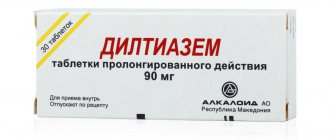Ranexa
Description
The mechanism of action of ranolazine still remains largely unknown. Ranolazine may have some antianginal effects by inhibiting late sodium current into myocardial cells. This reduces intracellular sodium accumulation and therefore reduces excess intracellular calcium ions. Ranolazine, by reducing late sodium current, is believed to reduce intracellular ion imbalance during ischemia. This reduction in excess intracellular calcium would be expected to promote myocardial relaxation and thus reduce ventricular diastolic tension. Inhibition of late sodium current by ranolazine is clinically manifested by a significant shortening of the QTc interval and a positive effect on diastolic relaxation, identified in an open study involving 5 patients with long QT syndrome (patients with LQT-3 syndrome having mutations in the SCN5A ?KPQ gene). These effects of the drug are independent of a decrease in heart rate, blood pressure, or vasodilation. Effects on Hemodynamics: Patients treated with ranolazine alone or in combination with other drugs intended for the treatment of angina in controlled studies experienced minimal reductions in mean heart rate (<2 beats per minute) and mean systolic blood pressure (<3 mmHg). Art.). Effects manifested by electrocardiography: In patients treated with Ranexa®, there was a prolongation of the QTc interval, depending on the dose and concentration in the blood plasma (about 6 ms when taking 1000 mg twice a day), a decrease in the amplitude of the T wave, in some cases, bihumped T waves. These effects of ranolazine on body surface electrocardiogram characteristics are thought to result from inhibition of the fast potassium current, which prolongs the ventricular action potential, as well as inhibition of the late sodium current, which shortens the ventricular action potential. A population-based analysis of pooled data from 1308 patients and healthy volunteers showed a mean QTc prolongation from baseline of 2.4 ms per 1000 ng/mL plasma ranolazine. The rate of extension was higher in patients with clinically significant liver failure. Clinical efficacy: Clinical studies have demonstrated the effectiveness and safety of Ranexa® when used to treat patients with chronic angina - both alone and in cases of obtaining a suboptimal positive effect from the use of other drugs intended for the treatment of angina. Controlled clinical trials included only a small proportion of non-white patients; therefore, it is not possible to draw conclusions regarding the effectiveness and safety of the drug for this group of patients.
Ranexa extended-release tablets 500 mg 60 pcs. in Moscow
Suction.
After oral administration of ranolazine, Cmax in blood plasma is usually achieved within 2–6 hours. When taking ranolazine 2 times a day, Cmax is usually achieved within 3 days.
The average absolute bioavailability of ranolazine after oral administration is 35–50%, with a high degree of individual variability. When the dose is increased from 500 to 1000 mg 2 times a day, a 2.5-3 fold increase in AUC at steady state is observed. In healthy volunteers, Css is approximately 1770 ng/ml; at steady state, AUC0–12 averages 13700 ng h/ml after taking ranolazine 500 mg 2 times a day. Food intake does not affect the rate and completeness of absorption of ranolazine. Distribution.
Approximately 62% of ranolazine is bound to plasma proteins, mainly alpha1-acid glycoproteins and slightly to albumin. Average Vss is about 180 HP.
Absorption
. After oral administration, the Cmax of ranolazine in plasma is reached between 2 and 5 hours. After oral administration of 14C-ranolazine in solution, 73% of the dose is found in the systemic circulation in the form of ranolazine or metabolites. The bioavailability of ranolazine when taking tablets is 76% compared to that when taking ranolazine solution. Because ranolazine is a P-gp substrate, P-gp inhibitors may increase the absorption of ranolazine.
Food (high-fat breakfast) does not have a significant effect on the Cmax and AUC of ranolazine. Thus, ranolazine can be used regardless of food intake. In the concentration range from 0.25 to 10 mcg/ml, approximately 62% of ranolazine is bound to human plasma proteins.
Metabolism
. Ranolazine undergoes rapid and almost complete metabolism in the liver. The most important metabolic pathways for ranolazine are O-demethylation and N-dealkylation. Ranolazine is metabolized mainly by the CYP3A4 isoenzyme, as well as the CYP2D6 isoenzyme. When taken 500 mg 2 times a day in people with insufficient activity of the CYP2D6 isoenzyme, the AUC value exceeds the same value for people with a normal metabolic rate by 62%. A similar difference for a dose of 1000 mg 2 times a day was 25%.
Selection
. Less than 5% of the administered dose of ranolazine is excreted unchanged by the kidneys and through the intestines. The clearance of ranolazine is dose dependent, decreasing as it increases. T1/2 of ranolazine at steady state after oral administration is about 7 hours.
Ranexa - a new milestone in the treatment of stable angina
As an advertisement
Modern medicine offers a wide range of drugs used to treat coronary heart disease, including both drug therapy and invasive treatment methods. But, despite all the advances in medicine, a significant proportion of patients suffering from coronary heart disease continue to experience symptoms of angina pectoris, which significantly limits their activity and reduces the quality of everyday life.
For these reasons, at the present stage, one of the main tasks in the treatment of patients with stable angina remains to reduce the frequency and intensity of angina attacks in order to improve the patient’s quality of life.
presents a new drug in its cardiology line - Ranexa®. Ranexa® is an innovative treatment for stable angina.
Ranexa® was first registered in the United States in 2006, where it was approved by the Food and Drugs Administration of the United States (FDA) as a drug for the treatment of stable angina. The drug has been on the European market since 2008.
Ranexa® is a new drug for the treatment of stable angina with an innovative mechanism of action that reduces ischemia in patients with stable angina.
The clinical manifestations of stable angina are based on transient myocardial ischemia, which is caused by a discrepancy between the myocardial oxygen demand and its delivery. Under conditions of ischemia, cardiomyocytes are overloaded with calcium ions, which in turn leads to impaired myocardial relaxation during diastole and impaired diastolic filling of the coronary arteries, provoking an attack of angina.
Ranolazine, the active ingredient of the original drug Ranexa®, is a powerful inhibitor of late sodium current. By selectively inhibiting the late sodium current, ranolazine prevents overload of cardiomyocytes with sodium ions, thereby blocking reverse sodium-calcium metabolism and, accordingly, the accumulation of calcium ions in the cell. It helps to improve the mechanical and electrical function of the myocardium by improving diastolic relaxation and coronary blood flow without affecting or independent of hemodynamic parameters. Thanks to this mechanism of action, the drug breaks the vicious circle of ischemia, restoring the balance between oxygen delivery and consumption by the myocardium.
The mechanism of action of ranolazine is unique and fundamentally new, which distinguishes it favorably from other classes of drugs for the treatment of stable angina and suggests the emergence of a new modern class of antianginal drugs.
The high efficacy and safety profile of ranolazine were studied in large multicenter clinical trials (MARISA, CARISA, ROLE, ERICA, MERLIN-TIMI, TERISA), which involved more than 8,000 patients. Ranolazine has an effective antianginal and anti-ischemic effect, has been proven to reduce the frequency of angina attacks and increases exercise tolerance in patients with stable angina.
The drug is included in European and American guidelines for the diagnosis and treatment of stable angina.
Ranexa® is available in two dosages: 500 mg and 100 mg. The recommended starting dose of Ranexa® is 500 mg 2 times a day. After 2–4 weeks, the dose, if necessary, can be increased to 1000 mg 2 times a day. The maximum daily dose is 2000 mg.
The drug can be used both as monotherapy and as part of a combination treatment of stable angina.
Proven clinical efficacy, a well-studied safety profile and excellent tolerability, hemodynamic neutrality, and the possibility of use in patients with concomitant diseases - all this can make it a good addition to the anti-ischemic drugs available in the doctor’s arsenal and take its rightful place among drugs for antianginal therapy.
Contraindications
- severe renal failure (creatinine clearance<30 ml/min);
- liver failure of moderate (7-9 points according to the Child-Pugh classification) or severe (more than 9 points according to the Child-Pugh classification) degree;
- simultaneous use with potent inhibitors of the CYP3A4 isoenzyme (itraconazole, ketoconazole, posaconazole, HIV protease inhibitors, clarithromycin, telithromycin, nefazodone);
- simultaneous use with class IA (eg, quinidine) or class III (eg, dofetilide) antiarrhythmic drugs other than amiodarone; sotalol;
- children and adolescents under 18 years of age (the effectiveness and safety of the drug have not been established);
- pregnancy;
- breastfeeding period;
- lactase deficiency, hereditary lactose intolerance, glucose-galactose malabsorption syndrome (only for 1000 mg);
- hypersensitivity to the components of the drug.
Ranexa®
Concomitant use is contraindicated
Potent CYP3A4 inhibitors
Ranolazine is a substrate of cytochrome CYP3A4. Concomitant use with inhibitors of CYP3A4 isoenzyme activity increases the concentration of ranolazine in the blood plasma. Potential dose-dependent side effects (eg, nausea, dizziness) may also increase with increasing plasma concentrations of the drug. Simultaneous treatment with ketoconazole 200 mg 2 times a day increases the AUC of ranolazine by 3-3.9 times.
The simultaneous use of ranolazine and potent inhibitors of the CYP3A4 isoenzyme (for example, itraconazole, ketoconazole, voriconazole, posaconazole, HIV protease inhibitors, clarithromycin, telithromycin, nefazodone) is contraindicated.
Grapefruit juice is also a potent inhibitor of the CYP3A4 isoenzyme.
Concomitant use with caution
Medium strength inhibitors of the CYP3A4 isoenzyme
Diltiazem (180-360 mg 1 time / day), an inhibitor of the CYP3A4 isoenzyme of moderate strength, causes, depending on the dose, an increase in the average Css value of ranolazine in blood plasma by 1.5-2.4 times. For patients receiving diltiazem and other moderately potent CYP3A4 inhibitors (e.g., erythromycin, fluconazole), dose titration of ranolazine is recommended. A dose reduction of ranolazine may be necessary.
Inducers of CYP3A4 isoenzyme activity
Concomitant use of ranolazine with inducers of CYP3A4 isoenzyme activity (rifampicin, phenytoin, phenobarbital, carbamazepine, St. John's wort (Hypericum perforatum)) may lead to a decrease in the effectiveness of the drug. For example, rifampicin (600 mg 1 time / day) reduces the Css of ranolazine in blood plasma by approximately 95%. Therefore, the use of ranolazine should not be started in patients receiving treatment with inducers of the CYP3A4 isoenzyme.
P-glycoprotein inhibitors
Ranolazine is a P-glycoprotein (P-gp) substrate. P-gp inhibitors (eg, cyclosporine, verapamil) increase ranolazine plasma concentrations. Verapamil (120 mg 3 times/day) increases the Css of ranolazine by 2.2 times. For patients receiving treatment with P-gp inhibitors, dose titration of ranolazine is recommended. A dose reduction of ranolazine may be necessary. On the other hand, ranolazine is a moderate P-gp inhibitor and a weak CYP3A4 inhibitor and may increase plasma concentrations of P-gp or CYP3A4 substrates. The tissue distribution of drugs that are transported by P-gp may be increased.
Substrates of the CYP2D6 isoenzyme
There is evidence that ranolazine is a weak inhibitor of the CYP2D6 isoenzyme. Taking ranolazine 750 mg 2 times a day increases the concentration of metoprolol in the blood plasma by 1.8 times. Therefore, when used simultaneously with ranolazine, the effect of metoprolol or other substrates of the CYP2D6 isoenzyme (for example, propafenone and flecainide, to a lesser extent, tricyclic antidepressants and antipsychotics) may be enhanced; therefore, a dose reduction of these drugs may be required.
Substrates of the CYP2B6 isoenzyme
The potential to inhibit the CYP2B6 isoenzyme has not been established. Caution is recommended when administered together with substrates of the CYP2B6 isoenzyme (for example, bupropion, efavirenz, cyclophosphamide).
Digoxin
There is evidence of an increase in the concentration of digoxin in the blood plasma by an average of 1.5 times with the simultaneous use of digoxin and ranolazine. Therefore, it is necessary to monitor digoxin levels at the beginning and after the end of ranolazine therapy.
Substars of the CYP3A4 isoenzyme
Ranolazine is a weak CYP3A4 inhibitor, which may result in increased plasma concentrations of CYP3A4 substrates and may require dose adjustment for sensitive CYP3A4 substrates (e.g., simvastatin, lovastatin) and CYP3A4 substrates with a narrow therapeutic index (e.g., cyclosporine, tacrolimus, sirolimus , everolimus).
Simvastatin
The metabolism and clearance of simvastatin is highly dependent on the CYP3A4 isoenzyme. Taking ranolazine 1000 mg 2 times a day increases the concentration of simvastatin lactone, simvastatin acid, which increases the inhibition of HMG-CoA reductase by 1.4-1.6 times. Taking simvastatin in high doses is associated with the development of rhabdomyolysis, and cases of rhabdomyolysis have also been described with the simultaneous use of ranolazine and simvastatin. The maximum dose of simvastatin for patients concomitantly taking ranolazine should not exceed 20 mg/day. For other statins metabolized by the CYP3A4 isoenzyme (lovastatin), dose limitation is possible.
Tacrolimus, cyclosporine, sirolimus, everolimus
An increase in plasma concentrations of tacrolimus, a substrate of the CYP3A4 isoenzyme, was observed in patients receiving ranolazine. When tacrolimus and ranolazine are used concomitantly, it is recommended to monitor the concentration of tacrolimus in the blood plasma and, if necessary, adjust the dose. This approach is also recommended for other CYP3A4 substrates with a narrow therapeutic index (for example, cyclosporine, sirolimus, everolimus).
Drugs that prolong the QT interval
There is a theoretical possibility that with simultaneous use of ranolazine and other drugs that prolong the QT interval, a pharmacodynamic interaction may occur and the risk of developing ventricular arrhythmias may increase. These drugs include certain antihistamines (eg, terfenadine, astemizole, mizolastine), certain antiarrhythmics (eg, quinidine, disopyramide, procainamide), and erythromycin and tricyclic antidepressants (eg, imipramine, doxepin, amitriptyline).



